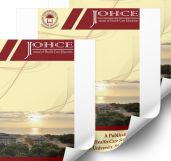Submission of manuscript
All manuscripts should be submitted to the Editor-in-Chief by email in word processing format as an email attachment.
We do not accept hardcopies of manuscript submission.
All correspondences related to the manuscript before/after submission should be sent to the Editor-in-Chief by email.
Email: johce_fhcs@esn.ac.lk
Selection for publication
Submitted manuscripts will undergo a desk evaluation by the editorial board for the appropriateness to the journal. Thereafter, if the manuscript is within the scope of the journal it will be sent for double-blind peer review by a minimum of two experts who will be asked to evaluate whether the manuscript is scientifically sound and coherent, whether it duplicates already published work, and whether or not the manuscript is sufficiently clear for publication. Reviewers will also be asked to indicate how interesting and significant the research is. The Editorial Board will reach a decision based on these reports.
The corresponding author will be notified as to whether or not their manuscript has been accepted and, if accepted, the suggestions given by the reviewers if any will be sent along. Upon completion of revision, corresponding author will have to submit the revised manuscript, which then will be reviewed again by the same reviewers or the editorial board. Decision of the editorial board will be conclusive.
